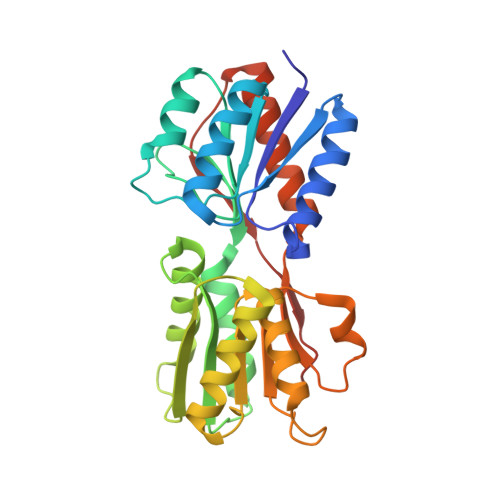Fructose 1-phosphate is the preferred effector of the metabolic regulator Cra of Pseudomonas putida
Chavarria, M., Santiago, C., Platero, R., Krell, T., Casasnovas, J.M., de Lorenzo, V.(2011) J Biol Chem 286: 9351-9359
- PubMed: 21239488
- DOI: https://doi.org/10.1074/jbc.M110.187583
- Primary Citation of Related Structures:
3O74, 3O75 - PubMed Abstract:
The catabolite repressor/activator (Cra) protein is a global sensor and regulator of carbon fluxes through the central metabolic pathways of gram-negative bacteria. To examine the nature of the effector (or effectors) that signal such fluxes to the protein of Pseudomonas putida, the Cra factor of this soil microorganism has been purified and characterized and its three-dimensional structure determined. Analytical ultracentrifugation, gel filtration, and mobility shift assays showed that the effector-free Cra is a dimer that binds an operator DNA sequence in the promoter region of the fruBKA cluster. Furthermore, fructose 1-phosphate (F1P) was found to most efficiently dissociate the Cra-DNA complex. Thermodynamic parameters of the F1P-Cra-DNA interaction calculated by isothermal titration calorimetry revealed that the factor associates tightly to the DNA sequence 5'-TTAAACGTTTCA-3' (K(D) = 26.3 ± 3.1 nM) and that F1P binds the protein with an apparent stoichiometry of 1.06 ± 0.06 molecules per Cra monomer and a K(D) of 209 ± 20 nM. Other possible effectors, like fructose 1,6-bisphosphate, did not display a significant affinity for the regulator under the assay conditions. Moreover, the structure of Cra and its co-crystal with F1P at a 2-Å resolution revealed that F1P fits optimally the geometry of the effector pocket. Our results thus single out F1P as the preferred metabolic effector of the Cra protein of P. putida.
Organizational Affiliation:
Systems Biology Program, Centro Nacional de Biotecnología-Consejo Superior de Investigaciones Científicas, 28049 Cantoblanco-Madrid, Spain.















